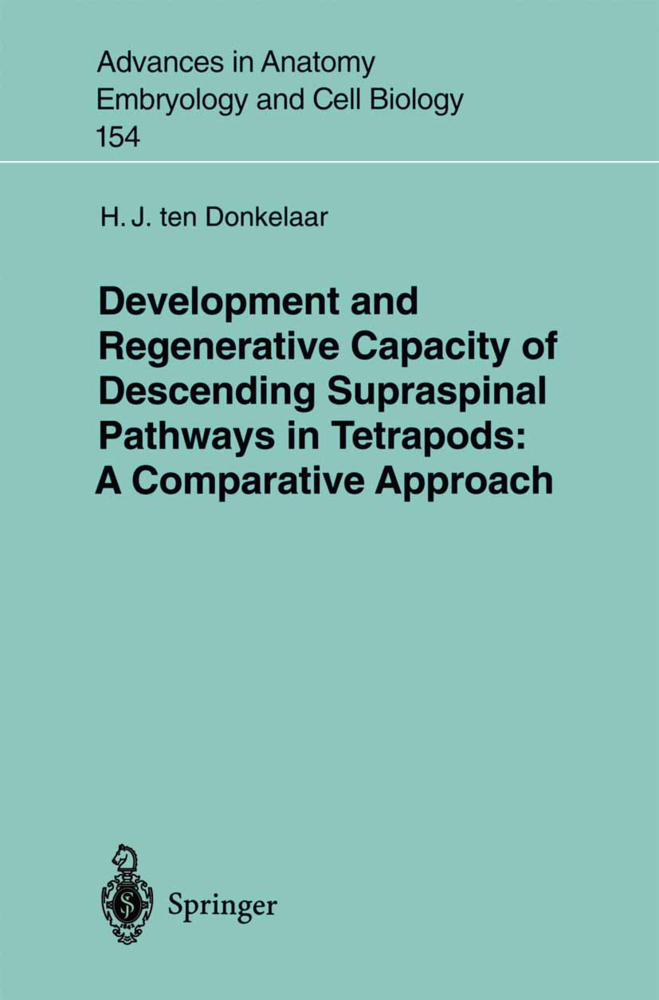Development and Regenerative Capacity of Descending Supraspinal Pathways in Tetrapods
Development and Regenerative Capacity of Descending Supraspinal Pathways in Tetrapods
In this treatise, current knowledge on the neurogenesis, axonal outgrowth, synaptogenesis, and regenerative capacity of descending supraspinal pathways in tetrapods is discussed. Although emphasis is on the clawed toad, Xenopus laevis, chicken embryos, opossum and rodent data, also the data available for primates including man are presented. It will be shown that 1) the outgrowth of descending supraspinal pathways is the result of a coordinated program; 2) the pattern of early descending axonal tracts is similar in all vertebrate groups; 3) the formation of descending supraspinal pathways occurs according to a developmental sequence; 4) the earliest descending supraspinal fibers arrive in a rather immature spinal cord, and 5) the regenerative capacity of descending supraspinal pathways depends on the developmental stage the particular pathways arise.
1.2 Attractive Animal Models for Studies on the Development of Motor Systems
1.3 Axonal Pathfinding
1.4 Regenerative Capacity of Descending Supraspinal Pathways
1.5 Scope of the Present Review
2 Materials and Techniques
2.1 Cytoarchitectonic Analysis
2.2 Immunohistochemical Procedures
2.3 Tract-Tracing Studies
2.4 [3H]-Thymidine Studies
3 Descending Pathways to the Spinal Cord in Tetrapods: A Brief Outline
4 Staging Systems
4.1 Systems for Staging Amphibian Embryos
4.2 Staging Chicken Embryos
4.3 Systems for Staging the Prenatal and Postnatal Development of Opossums
4.4 Systems for Staging Rodent and Primate Embryos
5 Development of Descending Supraspinal Pathways in Amphibians
5.1 Development and Regenerative Capacity of the Motor System in Urodeles
5.2 Development of Anurans: Two Motor Systems
5.3 Neurogenesis of Brainstem Motor Nuclei: Birthday Data in Xenopus laevis
5.4 Tract-Tracing Data in Anurans
6 Development of Descending Supraspinal Pathways in Birds
6.1 Some Notes on the Development of the Avian Brain Stem and Spinal Cord
6.2 Birthday Studies in Chickens
6.3 Tract-Tracing Data in the Chicken Embryo
7 Development of Descending Supraspinal Pathways In Opossums
7.1 Some Notes on the Development of the CNS in Opossums
7.2 Birthday Studies
7.3 Tract-Tracing Data in Opossums
8 Development of Descending Supraspinal Pathways in Placental Animals
8.1 Initial Tract Formation
8.2 Tract-Tracing Data in Rodents
8.3 Tract-Tracing Data in Cats
8.4 Tract-Tracing Data in Primates
9 Development of Descending Supraspinal Pathways in Man
9.1 Some Notes on the Development of the Human Spinal Cord
9.2 Development of Descending Brainstem Pathways in Man
9.3 Development of Corticospinal Projections in Man
10 Concluding Remarks
10.1 The Outgrowth of Descending Supraspinal Pathways Is the Result of a Coordinated Program
10.2 The Pattern of Early Descending Axonal Tracts Is Similar in All Vertebrate Groups
10.3 The Formation of Descending Supraspinal Pathways Occurs According to a Developmental Sequence
10.4 The Earliest Descending Supraspinal Fibers Arrive in a Rather Immature Spinal Cord
10.5 The Regenerative Capacity of Descending Supraspinal Pathways Depends on Their Developmental Stage
11 Summary
References.
1 Introduction
1.1 Phylogenetic Constancy of Descending Supraspinal Pathways1.2 Attractive Animal Models for Studies on the Development of Motor Systems
1.3 Axonal Pathfinding
1.4 Regenerative Capacity of Descending Supraspinal Pathways
1.5 Scope of the Present Review
2 Materials and Techniques
2.1 Cytoarchitectonic Analysis
2.2 Immunohistochemical Procedures
2.3 Tract-Tracing Studies
2.4 [3H]-Thymidine Studies
3 Descending Pathways to the Spinal Cord in Tetrapods: A Brief Outline
4 Staging Systems
4.1 Systems for Staging Amphibian Embryos
4.2 Staging Chicken Embryos
4.3 Systems for Staging the Prenatal and Postnatal Development of Opossums
4.4 Systems for Staging Rodent and Primate Embryos
5 Development of Descending Supraspinal Pathways in Amphibians
5.1 Development and Regenerative Capacity of the Motor System in Urodeles
5.2 Development of Anurans: Two Motor Systems
5.3 Neurogenesis of Brainstem Motor Nuclei: Birthday Data in Xenopus laevis
5.4 Tract-Tracing Data in Anurans
6 Development of Descending Supraspinal Pathways in Birds
6.1 Some Notes on the Development of the Avian Brain Stem and Spinal Cord
6.2 Birthday Studies in Chickens
6.3 Tract-Tracing Data in the Chicken Embryo
7 Development of Descending Supraspinal Pathways In Opossums
7.1 Some Notes on the Development of the CNS in Opossums
7.2 Birthday Studies
7.3 Tract-Tracing Data in Opossums
8 Development of Descending Supraspinal Pathways in Placental Animals
8.1 Initial Tract Formation
8.2 Tract-Tracing Data in Rodents
8.3 Tract-Tracing Data in Cats
8.4 Tract-Tracing Data in Primates
9 Development of Descending Supraspinal Pathways in Man
9.1 Some Notes on the Development of the Human Spinal Cord
9.2 Development of Descending Brainstem Pathways in Man
9.3 Development of Corticospinal Projections in Man
10 Concluding Remarks
10.1 The Outgrowth of Descending Supraspinal Pathways Is the Result of a Coordinated Program
10.2 The Pattern of Early Descending Axonal Tracts Is Similar in All Vertebrate Groups
10.3 The Formation of Descending Supraspinal Pathways Occurs According to a Developmental Sequence
10.4 The Earliest Descending Supraspinal Fibers Arrive in a Rather Immature Spinal Cord
10.5 The Regenerative Capacity of Descending Supraspinal Pathways Depends on Their Developmental Stage
11 Summary
References.
Ten Donkelaar, Hans J.
| ISBN | 978-3-540-66466-6 |
|---|---|
| Artikelnummer | 9783540664666 |
| Medientyp | Buch |
| Copyrightjahr | 2008 |
| Verlag | Springer, Berlin |
| Umfang | X, 145 Seiten |
| Abbildungen | X, 145 p. 40 illus. |
| Sprache | Englisch |











